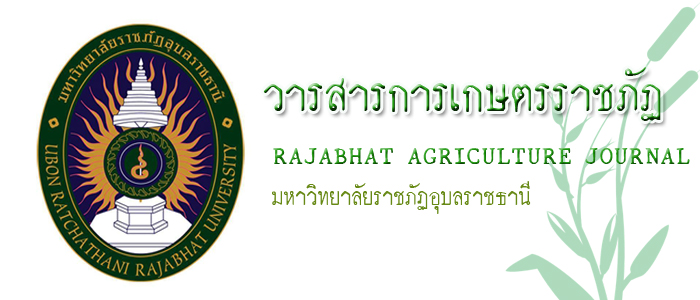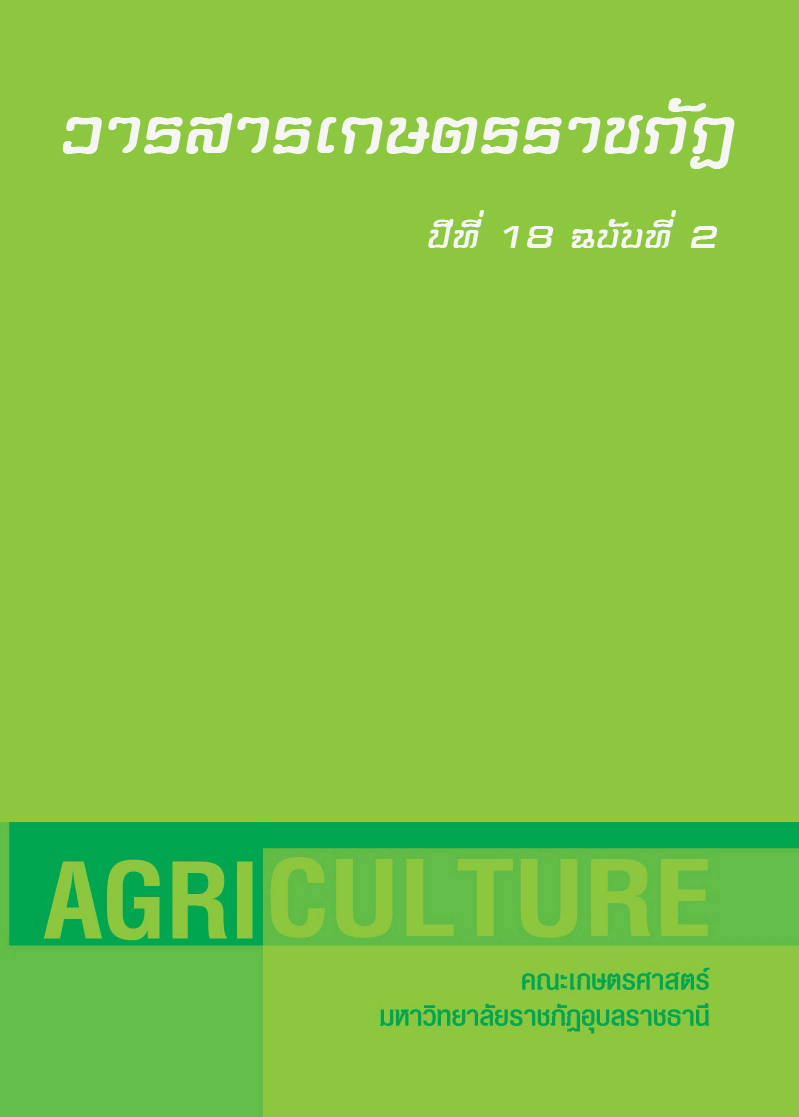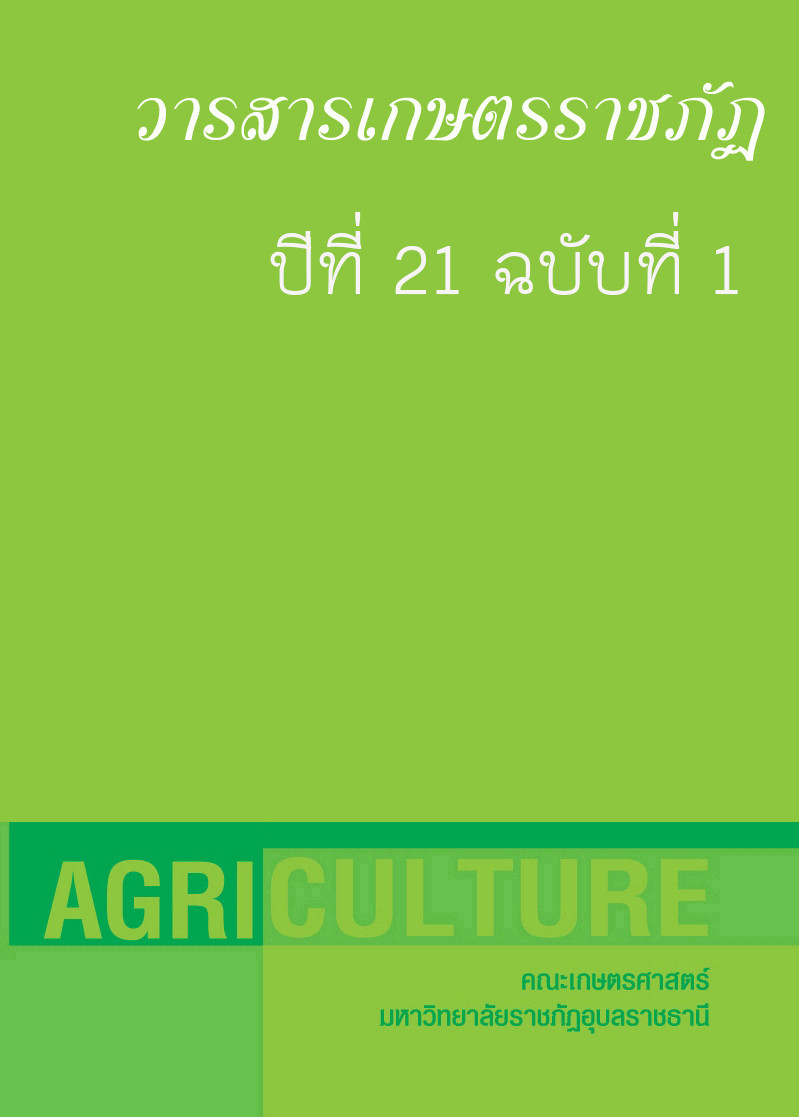การพัฒนาระบบจ่ายน้ำสกัดมูลสุกรแบบแม่นยำด้วยพลังงานแสงอาทิตย์ เพื่อแก้ปัญหาภัยแล้งหลังฤดูเก็บเกี่ยว
การพัฒนาระบบจ่ายน้ำสกัดมูลสุกรแบบแม่นยำด้วยพลังงานแสงอาทิตย์ เพื่อแก้ปัญหาภัยแล้งหลังฤดูเก็บเกี่ยว
Development of Automatic Swine Manure Fermented Fertilizer Water System Using Solar Energy to Solve Drought Problem of After Harvest Season
--------------------------------------------
โดย สุจิตรสุจิตรา สืบนุการณ์ สุรีรัตน์ บุตรพรหม นงลักษณ์ พยัคฆศิรินาวิน กิตติ วิรุณพันธุ์ เกศรา แก้วดี ภ
ประเภท : บทความวิจัย
ปีที่ตีพิมพ์ : วารสารเกษตรราชภัฏ ปีที่ 18 ฉบับที่ 2
ผู้เข้าชม 0
วันที่ปรับปรุงข้อมูล : 2020-11-18 09:50:39
ดาวน์โหลด
บทคัดย่อ
การพัฒนาระบบจ่ายน้ำสกัดมูลสุกรแบบแม่นยำด้วยพลังงานแสงอาทิตย์เพื่อแก้ปัญหาภัยแล้งหลังฤดูเก็บเกี่ยว การดำเนินงานวิจัยแบ่งออกเป็น 2 ระยะ โดยระยะแรก คือ การออกแบบและพัฒนาระบบจ่ายน้ำปุ๋ยมูลสุกรแบบแม่นยำด้วยพลังงานแสงอาทิตย์ ซึ่งออกแบบให้อาศัยแรงโน้มถ่วงของโลกเพื่อลดต้นทุนในการผลิต และใช้ระบบน้ำแบบหยดในการให้ปุ๋ย โดยมีชุดอุปกรณ์วัดความชื้นจำนวน 2 ชุด ชุดอุปกรณ์ควบคุมวาล์วน้ำ จำนวน 8 ชุด พร้อมแผงโซลาเซลล์ที่ควบคุมระบบการทำงาน สามารถตั้งค่าความชื้นที่ต้องการผ่านสัญญาณ wifi ในระบบมือถือ สำหรับระยะที่สอง คือ ศึกษาผลของการจ่ายน้ำสกัดมูลสุกรแบบแม่นยำด้วยพลังงานแสงอาทิตย์ต่อการเจริญเติบโตและการให้ผลผลิตของผักคะน้าและผักกวางตุ้ง โดยวางแผนการทดลองแบบ 2x4 Factorial in CRD มี 2 ปัจจัย คือ 1) ชนิดผัก ได้แก่ ผักคะน้า และผักกวางตุ้ง 2) อัตราส่วนของน้ำสกัดมูลสุกรต่อน้ำ มี 4 อัตราส่วน คือ 0 (ชุดควบคุม) 1:10 1:20 และ 1:30 ผลการทดลอง พบว่า เมื่อสิ้นสุดการทดลอง ผักกวางตุ้งเจริญเติบโตได้เร็วกว่าผักคะน้า มีจำนวนใบเฉลี่ย/ต้น ความยาวใบเฉลี่ย เส้นผ่าศูนย์กลางลำต้นเฉลี่ย น้ำหนักลำต้นสดเฉลี่ย และปริมาณคลอโรฟิลล์รวมในใบเฉลี่ยมากที่สุด คือ 10.63
คำสำคัญ: น้ำสกัดมูลสุกร ระบบการจ่ายน้ำ พลังงานแสงอาทิตย์
Abstract
Development of Automatic Swine Manure Fermented Fertilizer Water System Using Solar Energy to Solve Drought Problem of After Harvest Season. The research was divided into 2 parts. The first part was the design and development of accurate solar system for the swine manure irrigation. The liquid fertilizer delivering system exploited gravitational force. This design was to reduce production cost. Fertilizer was carried with water dripping system. There were 2 sets of moisture meter, 8 valve control units and a solar panel. Controlling can be manipulate through wifi smart phone. The second part was to study the effective of the system on 2 vegetable species, Chinese kale and False Pakchoi. The project was laid out with 2x4 Factorial in CRD. The 2 factors were 1) vegetable species 2) Four ratios of swine manure fertilizer to water ie. Control, 1:10, 1:20 and 1:30. It was found that False Pakchoi grew better than Chinese kale with average leaf numbers plant, leaf length, stem diameter, stem fresh weight and total leaf chlorophyll of 10.63 leaves, 19.67 cm., 25.30 mm., 1,624 kg/rai and 0.14 g/l, respectively. The difference was statistically significant. There were 2 cases of appropriate ratio of the fertilizer. At 1:20 ratio resulted in the better growth with 9.38 leaf numbers plant and stem diameter of 19.64 mm. If optimum yield is required then 1:30 ratio is most suitable. This ratio gave 1,340 kg/rai, and tended to give the highest average leaf chlorophyll of 0.12 gl-1. If relationship between vegetable species and different ratio of the liquid fertilizer were considered then the most optimum ratios for Chinese kale was 1:10. This ratios resulted in the highest average in height, weight and leaf chlorophyll. This was also true with False Pakchoi at the ratio of 1:30.
Keywords: Swine Manure Fermented, Automatic Water System, Solar Energy


